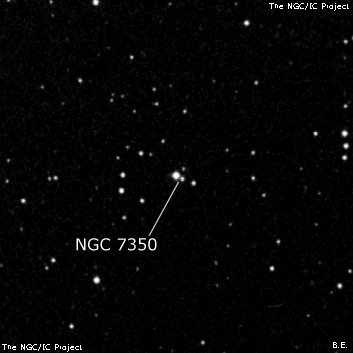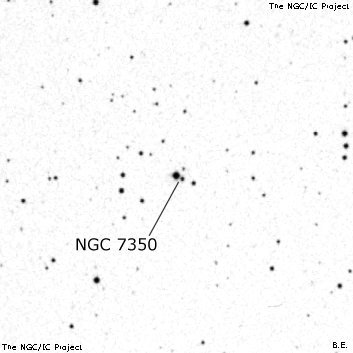NGC/IC Project Restoration Effort
(This is a very very beta version)
NGC7350


Basic Information
Location and Magnitude
Right Ascension: 22:40:48.2
Declination: +12:0:25
Constellation: PEG
Visual Magnitude:
Historic Information
Discoverer: Marth
Year of discovery: 1864
Discovery aperture: 48.0
Observational
Summary description: vF
Sub-type: *2
Corwin's Notes
=====
NGC 7350 and NGC 7353. Here is what I wrote earlier about this puzzling pair:
[These] are two of a trio of nebulae discovered by Marth in August 1864.
The third object, found the same night as N7350 and N7353, is N7348 and is
the only one of the three listed near its discovery position in modern
catalogues. N7350 is given as non-existent in RNGC which also suggests the
galaxy at 22 39.6, +11 47 (J2000) as N7353. RC3 accepted this
identification. This, however, is incorrect as there is a faint galaxy
close to Marth's position (22 41.4, +11 56; J2000) that he could have seen
with Laselle's 48-inch reflector. N7350 is possibly a star with one or two
faint companions, again near its discovery position. While the
identification of NGC 7350 is not secure, that for NGC 7353 is. So, RC3 and
RNGC got the wrong object.
Running across this again in May 2016, I'm not happy with this. I've demoted
my previous identifications -- a triple star and KUG 2213+116 -- with question
marks, and have cast around for other objects. Here is what I've come up with
so far.
Of the 24 objects that Marth found on the night(s) of 1864.60 (8+- August),
these (and NGC 7283, which see) are the only ones with no obvious objects on
the sky near his positions. There is no significant offset between Marth's
positions and the modern positions for the other 21 objects, and the standard
deviations are just 0.4 arcminutes in RA and 0.9 arcminutes in declination.
Thus, only a real blunder could account for the big differences between
Marth's positions and whatever the positions are for the actual objects he
saw.
I think it more likely that Marth found a pair of galaxies separated by about
20 seconds of time and 2 arcminutes, oriented northwest-southeast. Such a
pair exists in the area -- NGC 7346/47 -- but Marth himself found the fainter
of these, NGC 7346, on the same August 1864 night(s) as he recorded N7350/53.
The only possibility then, for this to be his pair is if he actually found
N7346 on a different night than he found NGC 7350/53. This would also require
that he recognized the accompanying galaxy as h 2176 on one night, but not the
other. This is getting pretty far-fetched, isn't it ...
Marth's descriptions don't help as he calls N7350 "vF" and N7353 "eF". N7347
is nearly edgewise, and considerably brighter than N7346, so I would have
expected that not only would the brightness estimates would be reversed, but
that N7353 would have been called "E" (as JH did), or even "mE". So, I regard
the N7346/47 hypothesis as no more than a remote possibility, and put it into
the position table with double question marks.



